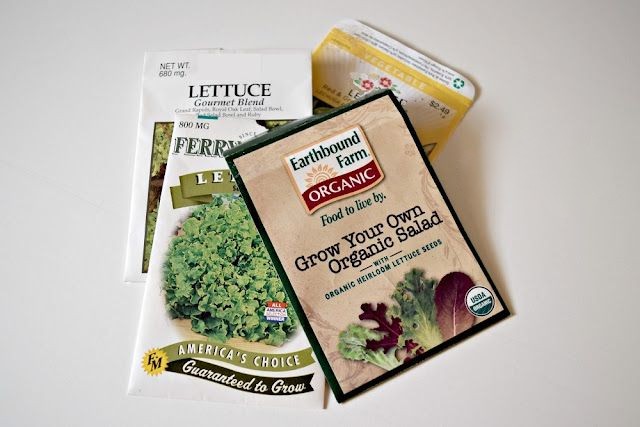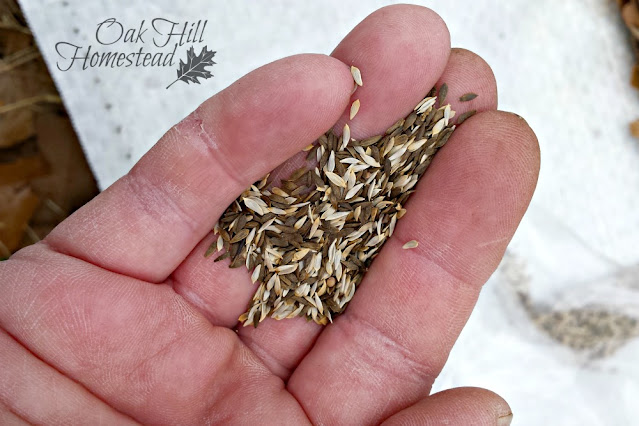Whether you're a seasoned gardener or a beginner, lettuce is an easy and quick crop to grow. These essential steps will help you grow lettuce in your backyard garden. Here's how to cultivate crisp, delicious and nutritious lettuce.
How to grow lettuce in your backyard garden
Looseleaf lettuce is very easy to grow and can be harvested in about four weeks.
With garden space at a premium, growing a mix of lettuce varieties helps to prevent boredom. After all, variety is the spice of life, and that certainly applies to the dinner table.
So why grow just one kind? I'll show you how to grow a signature blend of your favorite lettuce varieties!
What is loose leaf lettuce
Loose leaf lettuce is a much better choice for home gardeners than the typical iceburg lettuce you'd buy in the grocery store.
Loose leaf lettuce is lettuce that doesn't form a head. Some seed catalogs will classify them further as butterhead, batavian, Bibb and many more.
This kind of lettuce grows more quickly and takes up less space in the garden than head lettuce.
Loose leaf lettuce is a "cut and come again" kind of plant. In other words, the outer leaves can be removed and eaten, while the rest of the plant is left in the ground and continues to grow.
This is another reason it's a better choice: you can pick a few leaves from this plant and a few more from that plant, just enough for one salad.
By growing several loose leaf lettuce varieties, you can eat a different mixed salad every day.
Loose leaf lettuce varieties
Several seed companies offer a pre-packaged mix of lettuce seeds. Their mixtures are often referred to as mesclun, although according to Wikipedia a true mesclun blend is "a salad mix of assorted small, young salad green leaves, which originated in Provence, France."
This original French mix included chervil, arugula, leafy lettuces, endive and chive, but the modern-day usage of the term seems to refer simply to a mix of early leaf lettuces and greens.
For example, Burpee's packet of mesclun seeds includes "a tender, mild flavored blend of leaf veggies for early spring salads."
This seed packet includes both red and green types including Ruby lettuce, Bull's Blood, spinach, mustard and Simpson lettuce.
Baker's Creek Seeds describes their mesclun mix as "sweet-mild to sour-hot-tangy, and colors [of] red, purple, yellow, and green."
Their packet includes colorful lettuces plus radicchio, arugula, endive, orach, mizuna, kale, mustard, and corn salad.
I've grown several of these mixes in the past but I enjoy mixing it up every year. So if I can't find pre-mixed seeds, I buy a couple packets of different varieties and plant some seeds from each one.
Last year I was low on lettuce seed, and some of my partial packets were a couple of years old, so I decided to plant all that I had on hand.
I emptied all my saved lettuce seeds into one bowl and planted them all.
All those different varieties and colors made a very pretty garden and some pretty, colorful salads too, with a big range of flavors.
How to plant lettuce
Lettuce needs an average, well-drained soil that is kept moist and a soil temperature between 55° and 75°. Most lettuce seeds won't germinate when the soil is over 80°F.
It can be easy to plant small lettuce seeds too thickly. My grandmother taught me to mix the seeds with some sand and sow this mixture. This trick works for any small seeds.
Leaf lettuces can be planted closer together than head lettuces though, so it's also a great space saver.
The seeds should be planted about 1/8" deep, or sprinkled on the garden bed and covered lightly with soil. They should sprout in about 5-8 days.
When to plant lettuce seeds
Lettuce grows well in cool weather and can withstand a light frost, so it's one of the first things you can plant in the spring.
Plant lettuce seeds about two weeks before your area's last frost date. (You can find your average last frost date by entering your zip code here.)
Lettuce likes cool soil and may bolt or become bitter if the temperature is too hot.
You can stretch your season by planting loose leaf lettuce next to plants that will grow taller than the lettuce as the season progresses - tomatoes, for instance - so the lettuce will be in their shade when the weather gets hot.
Lettuce is a good crop for that shady corner of your garden, which will be cooler once the temperature warms up.
You can grow lettuce in a large container, and move it into a shadier spot as the season progresses to keep the soil shaded and cooler.
Add other salad ingredients and grow your own healthy salad garden in a small space.
How to pick leaf lettuce so it keeps growing
By harvesting lettuce leaves individually and leaving the rest of the plant to keep growing, lettuce will give you an abundant harvest over a long period of time.
You can begin harvesting the outer leaves from your plants when they are about three inches tall, which will take about four weeks from planting date.
If you need a larger harvest, you can cut the entire plant about an inch above the soil. The plants will continue to grow back and you'll get two, three or maybe even four harvests from each plant this way.
You can also plant in succession. By planting several rows of seeds about 2-3 weeks apart, you can have a pretty steady supply of salads until the weather gets too hot.
The best way to store lettuce after harvesting
Harvest lettuce early in the day. Lettuce contains the most moisture in the morning, so it will stay crisper after picking.
Rinse the leaves gently. Gently wash off any dirt or bugs using cool water.
Dry thoroughly - pat the leaves dry with a clean towel.
Wrap them loosely in a paper towel, then store in a container or plastic bag. The paper towel will help to absorb any remaining moisture.
Store the container or bag in the crisper drawer of your refrigerator, where the temperature is more likely to stay at a consistently cool temperature.
If the leaves start to wilt, soak them in a bowl of ice water for about 10 minutes, then dry them again.
For a delicious dressing that will really change up your salad, try my friend Michelle's maple vinaigrette salad dressing.
How to grow your own signature blend of loose leaf lettuce
Can't find a prepackaged lettuce seed mixture that appeals to you? You can create your own signature blend by purchasing seeds of several loose leaf lettuce varieties.
Life is too short to stick to just one kind of lettuce!
Choose different flavors, textures and colors to create variety for both your eyes and your palate.
For instance, you could begin with some spinach or chard seeds, then add a lettuce variety with frilly leaves such as Black-Seeded Simpson, a stunning red variety such as this Flame Lettuce, and a lettuce with smooth leaves like Bibb lettuce, all from Mary's Heirloom Seeds.
Add some spicy arugula and mustard if you like.
Then add a buttercrunch variety for an interesting change of texture.
Or choose one of these lettuce combo packs to start with:
You'll probably have more seeds than you'll plant in one year, but you can save the leftover seeds to plant next spring too.
Harvest lettuce seeds
When the weather heats up, your lettuce plants will "bolt" or go to seed.
They'll begin growing straight up, and eventually you'll see a stalk beginning to grow up the middle, with additional leaves growing from this stalk instead of from the bottom of the plant.
This stalk with eventually produce flowers, and then seeds, which can be harvested and saved for next year.
I recommend growing and saving heirloom seeds. Hybrid seeds may not grow true to their parent plants. You can read more about heirlooms and hybrids in this article.
Last summer I let a few plants that were left in my lettuce patch bolt go to seed. I harvested some of the seeds, but I'm also hoping that next spring there will be a variety of self-seeded plants popping up in that garden bed, which can be gently transplanted if needed.
Want more gardening and simple living information? Subscribe to The Acorn, Oak Hill Homestead's weekly-ish newsletter, and join me on Facebook, Instagram and Pinterest. I'd love to see you there!















